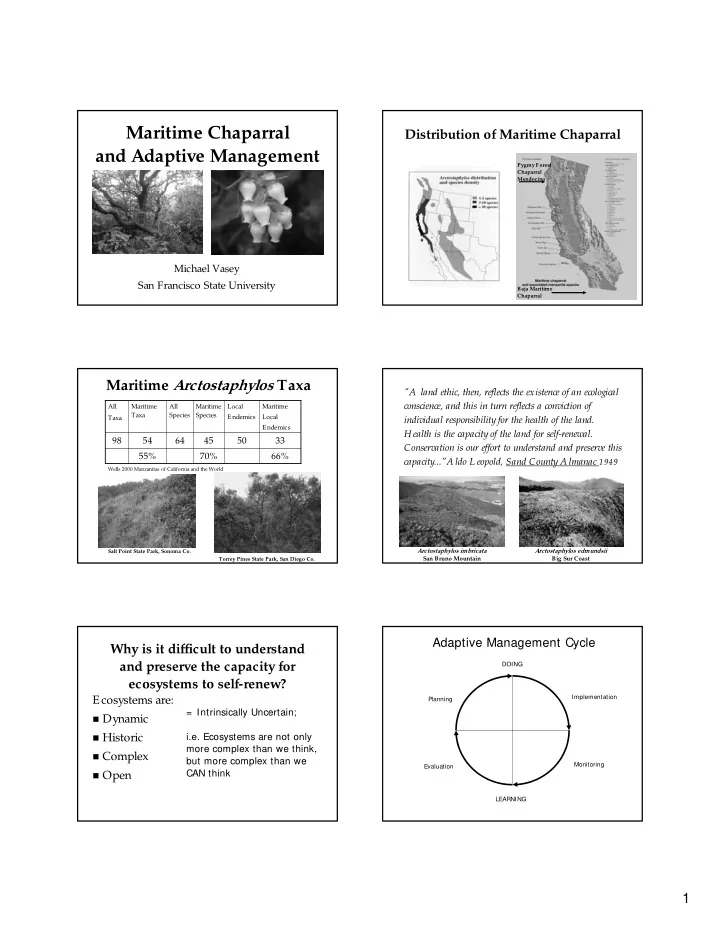

Maritime Chaparral Maritime Chaparral Distribution of Maritime Chaparral Distribution of Maritime Chaparral and Adaptive Management and Adaptive Management Pygmy Forest Chaparral Mendocino Michael Vasey Michael Vasey San Francisco State University San Francisco State University Baja Maritime Chaparral Maritime Arctostaphylos Maritime Arctostaphylos Taxa Taxa "A land ethic, then, reflects the existence of an ecological conscience, and this in turn reflects a conviction of All All Maritime Maritime All All Maritime Maritime Local Local Maritime Maritime Taxa Taxa Species Species Species Species Taxa Endemics Endemics Local Local Taxa individual responsibility for the health of the land. Endemics Endemics Health is the capacity of the land for self-renewal. 98 98 54 54 64 64 45 45 50 50 33 33 Conservation is our effort to understand and preserve this 55% 55% 70% 70% 66% 66% capacity..."A ldo L eopold, Sand County A lmanac 1949 Wells 2000 Manzanitas of California and the World Salt Point State Park, Sonoma Co. Arctostaphylos imbricata Arctostaphylos edmundsii San Bruno Mountain Big Sur Coast Torrey Pines State Park, San Diego Co. Adaptive Management Cycle Why is it difficult to understand Why is it difficult to understand and preserve the capacity for and preserve the capacity for DOING ecosystems to self- -renew? renew? ecosystems to self Ecosystems are: Implementation Ecosystems are: Planning = Intrinsically Uncertain; � Dynamic Dynamic � � Historic Historic i.e. Ecosystems are not only � more complex than we think, � Complex Complex � but more complex than we Monitoring Evaluation CAN think � Open Open � LEARNING 1
Adaptive Management Cycle Begins with Assessing What is Known Implementation Planning 1. What experimental and observational data Evaluation pertains to your system; i.e. what do we know or at least Odion and Tyler. 2002. Are long fire-free periods needed to maintain the endangered think we know? fire-recruiting shrub Arctostaphylos morroensis (E ricaceae). Conservation Ecology 6 (2):4 C A B Present extent of Arctostaphylos pajaroensis 0 2 4 6 8 Kilometers Pajaro River 6 36 52'30" E 7 Elkhor n D Slough Monterey 4 3 # Prunedale A. New Burn Bay 5 2 1 B. 1 Year Burn C. 3 Year Burn 36 45' 121 37'30" 121 45' D.20 Year Burn E. 40+ Year Burn Van Dyke, Holl and Griffin. Maritime chaparral community transition in Santa Monica the absence of fire. Mountains Santa Monica Mountains Santa Monica Mountains 2
Integrated Regional Wetland Monitoring Program (IRWM) Adaptive Management Cycle Then Develops a Conceptual Model to Frame Questions Implementation Planning 1. What experimental 2. Develop a and observational data conceptual model pertains to your and identify questions system; i.e. what do we know or at least think we know? Integrated Conceptual Model Adaptive Management Cycle Then Moves into a Planning Process 3. Identify issues and stakeholders, set goals, Implementation design projects to test hypotheses, begin with the end in mind 1. What experimental 2. Develop a and observational data conceptual Model pertains to your and identify questions system; i.e. what do we know or at least think we know? IRWM Wetland Vegetation Conceptual Model Adaptive Management Cycle A & B – – Observation Observation A & B DOING C C – – Trial and Error Trial and Error D – D – Passive Adaptive Passive Adaptive Implementation Planning Management Management E & F – – Active Adaptive Active Adaptive E & F Management Management Elzinga et al. 2001 Monitoring Monitoring Evaluation Plant and Animal Populations What are the best metrics? What is the best way to LEARNING analyze the data? 3
Summary Summary � There is a tremendous amount that we still don’t know! Conserving maritime chaparral is a daunting task yet failure to conserve maritime chaparral risks a vital part of California’s natural heritage � Coordinate efforts of academia, agencies, and the public to generate better understanding of the dynamics of maritime chaparral (build conceptual model) � Use management activities to stimulate large scale experimentation (adaptive management) that builds understanding � Conduct more experimental work on maritime chaparral; e.g. seed banks and seedling survival, and devlop predictive models that can be tested in the field � Focus on restoring diversity and consider multiple species and life histories in an experimental context � Be opportunistic! Learning must have as Mt. Tamalpais, Marin County high a priority as doing. Cultivate a land ethic throughout the community 4
Recommend
More recommend